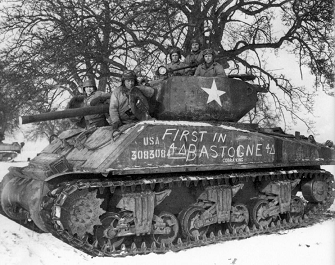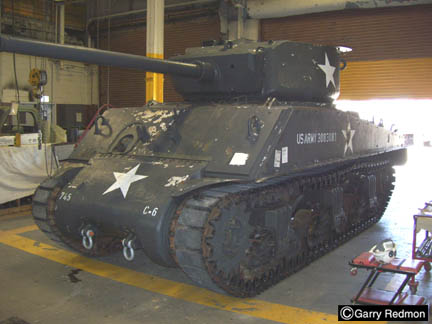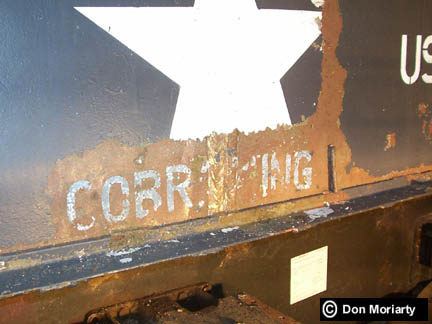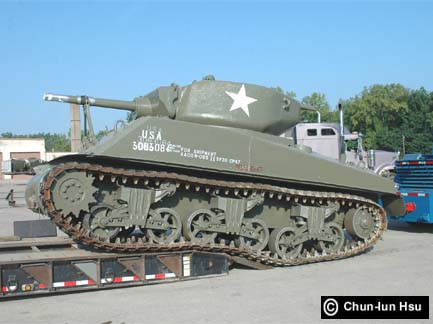World War II’s most famous US tank—the one that broke German siege lines at Bastogne 70 years ago in the Bulge—is restored and ready for display. She’s just waiting for the museum where she’ll rest to be constructed.
by James George
It’s November 2014—almost six years since Cobra King, the American Sherman Jumbo M4A3E2 assault tank famous for being the first to break through the German lines surrounding Bastogne, Belgium, returned to the United States. Now, after years of restorative work, the tank is ready for display, but in a museum facility that has not yet been built.
 After World War II, the historic tank’s whereabouts were unknown, and remained so until 2004. That year, army Chaplain Keith Goode became curious about the old tank on display near the back gate of the US Army’s Rose Barracks at Vilseck, Germany. After examining the tank, he came to believe it was actually the famous Cobra King. Armor experts looked into the matter, and in December 2008 they officially confirmed the tank’s identity. Cobra King had emerged from the shadows.
After World War II, the historic tank’s whereabouts were unknown, and remained so until 2004. That year, army Chaplain Keith Goode became curious about the old tank on display near the back gate of the US Army’s Rose Barracks at Vilseck, Germany. After examining the tank, he came to believe it was actually the famous Cobra King. Armor experts looked into the matter, and in December 2008 they officially confirmed the tank’s identity. Cobra King had emerged from the shadows.
In July 2009, the US Army Center of Military History shipped Cobra King from Germany to the Patton Museum at Fort Knox, Kentucky, for restoration work. Len Dyer, former director of the Patton Museum and now director of the National Cavalry Museum at Fort Benning, Georgia, helped restore the newly returned tank. In a phone interview early this month (November 2014), he noted that the most difficult component of the restoration process was finding replacement parts from original sources. That’s the challenge with most artillery refurbishment projects, he said.
 In the case of Cobra King, the goal of the restoration process wasn’t to make the tank operational, said Dyer, but to make it as historically accurate as possible. The restoration staff used archived photos of the tank and Sherman M4A3E2 technical manuals during the process, Dyer said. These materials helped restoration workers ensure historical accuracy.
In the case of Cobra King, the goal of the restoration process wasn’t to make the tank operational, said Dyer, but to make it as historically accurate as possible. The restoration staff used archived photos of the tank and Sherman M4A3E2 technical manuals during the process, Dyer said. These materials helped restoration workers ensure historical accuracy.
Locating an original Ford V-8 engine and matching Cobra King’s original tracks were two major difficulties of the restoration process, said Dyer. When the tank was identified in Germany, it was missing its engine, so the team at Fort Knox faced the challenge of finding a period replacement. And Cobra King’s original tracks were difficult to restore because they had a unique addition: a duckbill, or metal extension used to compensate for the tank’s extra weight when traveling over marshland.
 Cobra King’s war service didn’t end with that triumphant moment at Bastogne on December 26, 1944. In fact, damage from later combat would prevent restoration of the tank’s interior.
Cobra King’s war service didn’t end with that triumphant moment at Bastogne on December 26, 1944. In fact, damage from later combat would prevent restoration of the tank’s interior.
Physical evidence showed that an explosion caused an internal fire, destroying the tank’s interior, and causing the famous “First in Bastogne” tank to be unceremoniously abandoned. When, decades later, the tank was identified and returned to the United States, says Dyer, the restoration staff decided the extent of the damage made interior restoration impossible.
The damage, the restoration crew came to believe, may have happened in one of World War II’s more controversial raids. In the process of researching the tank’s history, said Dyer, a combination of physical and photographic evidence, primary sources, and historical records led the team at Fort Knox to conclude that Cobra King may have participated in the disastrous Hammelburg Raid of late March 1945, in Germany. The raid was a secret mission to penetrate German lines, liberate the Oflag XIII-B POW camp near Hammelburg, and return safely with US officers held there. One of the POWs at the camp was the son-in-law of Lieutenant General George Patton, who ordered the raid, and this later raised questions about the mission’s legitimacy.
Conducted by Task Force Baum, under the capable and seasoned Captain Abraham Baum, the Hammelburg Raid failed when it became trapped by German forces. In the end, 32 Americans were killed and some 247 others were wounded, missing, or captured. One casualty of the Hammelburg Raid seems to have been Cobra King. The tank’s company participated in the raid, and Captain Baum even mentioned a tank named Cobra King in his postwar account of the operation. There are photographs of a disabled Sherman Jumbo tank in the years just after the war at a US transportation center—in Hammelburg.
 Despite the challenges of Cobra King’s restoration, Dyer says, it was a successful project. After two years of work at Fort Knox, the tank was shipped out on July 29, 2011, and arrived safely at Fort Benning, Georgia, the following day. Cobra King is now in storage at Fort Benning, says Dyer, and functions as an educational tool for the US Army Armor School. According to Dyer, the tank will eventually be displayed at the National Armor and Cavalry Museum at Fort Benning, still in the process of raising construction funds. Although a building is not yet built, Dyer says, he envisions the tank as part of a large diorama, which will be a central feature of the museum.
Despite the challenges of Cobra King’s restoration, Dyer says, it was a successful project. After two years of work at Fort Knox, the tank was shipped out on July 29, 2011, and arrived safely at Fort Benning, Georgia, the following day. Cobra King is now in storage at Fort Benning, says Dyer, and functions as an educational tool for the US Army Armor School. According to Dyer, the tank will eventually be displayed at the National Armor and Cavalry Museum at Fort Benning, still in the process of raising construction funds. Although a building is not yet built, Dyer says, he envisions the tank as part of a large diorama, which will be a central feature of the museum.
In addition to Cobra King, the National Armor and Cavalry Museum will feature the armor collection previously displayed at the Patton Museum at Fort Knox.
The men who operated Cobra King or fought alongside her during World War II are all gone now. The last survivor of Cobra King’s home unit—Charlie Company, in the 4th Armored Division’s 37th Tank Battalion—passed away in 2009, the year the tank returned to the States for restoration. The refurbished Cobra King will be a monument to their service and, once on display as an artifact, will enable future generations to learn their story.
For more information on the restoration of Cobra King, including photos, visit the Cobra King Project page on the Armor for the Ages website.
Photos, from top:
• The five-man crew of the M4A3E2 Sherman Jumbo assault tank Cobra King poses for a triumphant photo with their siege0-breaking war machine. NATIONAL ARCHIVES
• Cobra King sits in a shop at the Patton Museum at Fort Knox, Kentucky, awaiting the start of a lengthy restoration project. PHOTO COURTESY OF GARRY REDMON
• The stenciled name Cobra King emerges from beneath layers of paint during the refurbishment. This is on the tank’s right side, not visible in photos shot after the liberation of Bastogne. No one was sure whether the name was painted on both sides of the tank. PHOTO COURTESY OF DON MORIARTY
• Restored to her December 1944 exterior appearance (and with her 1945 burned-out interior stabilized but left unrestored), Cobra King is loaded onto a trailer at Fort Knox for transport to Fort Benning, where she remains today. PHOTO COURTESY OF CHUN-LUN HSU


FOLLOW US »
